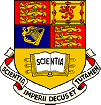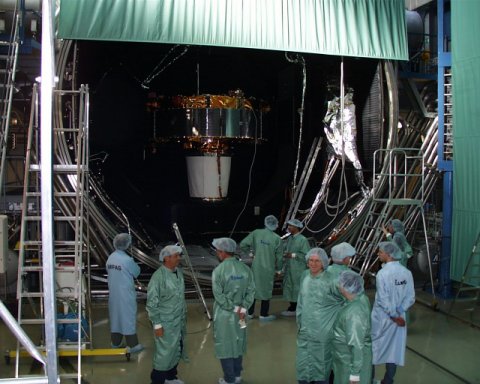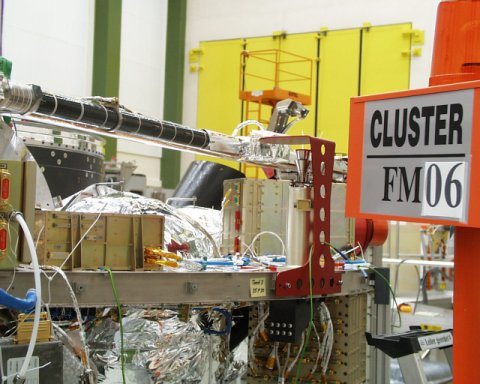
 |
|
News Page |

May 1999 |
This month's news stories:GERB calibrationCluster news |
Final calibration of the GERB flight instrument was completed this month in the new Earth Observation Characterisation Facility (EOCF) at IC. Due to schedule pressures time was very limited and the SPAT GERB team (Justin Ashmall, Helen Brindley, Neil Cooke, Steve Kellock, Ruzbeh Mossavati and Ray Wrigley), with support from the Rutherford Appleton Laboratory, worked around-the-clock for 5 weeks to complete an exhaustive set of measurements that were originally planned to be made over 20 weeks.
During this intense period of activity, the instrument's response to a number of calibrated radiometric sources was measured, together with its response as a function of wavelength and intensity. The in-flight calibration source was also measured and characterised. Since GERB is an imaging instrument, its imaging performance (point-spread-function) had to be measured. This particularly challenging task involved scanning a highly-collimated laser beam in angular steps of 7 thousandths of a degree in the instrument aperture and took more than 10 days. The result is a detailed map of the angular response of each of GERB's 256 pixels. The accompanying picture shows the response of one pixel and is composed of more than 2,000 measurement points.
It will take a long time to fully process all the data collected during this period but preliminary results show that the instrument is indeed satisfying the very stringent performance requirements levied on it.
GERB is designed to measure the Earth's Radiation Budget and will be launched on a Meteosat Second Generation satellite (MSG-1) in October 2000. It has been built by a consortium led by Imperial College and managed by the Rutherford Appleton Laboratory. Funding has been approved to build two further GERB instruments for flights on MSG-2 and MSG-3 in 2002 and 2007 respectively.
Steve Kellock 30th April 1999
|
The SPAT Cluster-II team were again on the road in April continuing testing the first of the four FGM magnetometers to be integrated onto its spacecraft. This time the team (Chris Carr, Patrick Brown and Julian Harris) travelled to Munich, Germany to support the Thermal Vacuum tests on the completed FM6 Cluster Spacecraft. During this test, the whole spacecraft is mounted inside the giant thermal vacuum tank at the Industrie Anlagen Betriebsgesellschaft (IABG) test facility, as shown in the upper picture on the right. During the 8 day campaign, Patrick and Julian, closest to the front on the right hand side of the picture, supported four 12 hour NOrmal Mission Operation Phase (NOMOP) tests designed to simulate actual in-orbit operation of all spacecraft systems and all experiments, with our instrument, the magnetometer (FGM) being a critical part. Also two integrated system tests were performed, one in the cold thermal phase and one in the hot thermal phase. As expected, FGM performed perfectly and correctly delivered its vital magnetic field data to 5 other experiments on the spacecraft. Although well underway, work for the Cluster 2 FGM team is far from over. More integrated system tests are due to start on the second spacecraft (Cluster-II FM-7) this month, with the remaining two magnetometers being completed for delivery and spacecraft integration in the summer. The second picture shows the magnetometer electronics unit (built at Imperial College) mounted on the spacecraft platform during the integration of the spacecraft in the Dornier Satellitensytem GmbH assembly hall in Friedrichshafen, Germany. Above the electronics unit, a portion of the magnetometer boom can be seen on which our two tri-axial sensors are mounted. This boom will be deployed in space to enable the instrument to measure accurately the very small magnetic fields in the Earth's space environment. This spacecraft is the sixth one built, the first four were blown up in the launch accident of Ariane 5 in June 1996. The four newly built spacecraft will be completed early next year and launched from Baikonour, Kazakhstan, on two Soyuz launchers in June and July 2000. The scientific objective of the mission is the study of the three-dimensional aspects of the Earth's magnetosphere. Imperial College London is the Principal Investigator institution on the Magnetic Field Investigation. Julian Harris & André Balogh 5th May 1999 |
  |
View last month's news, older news or return to Space and Atmospheric Physics home page